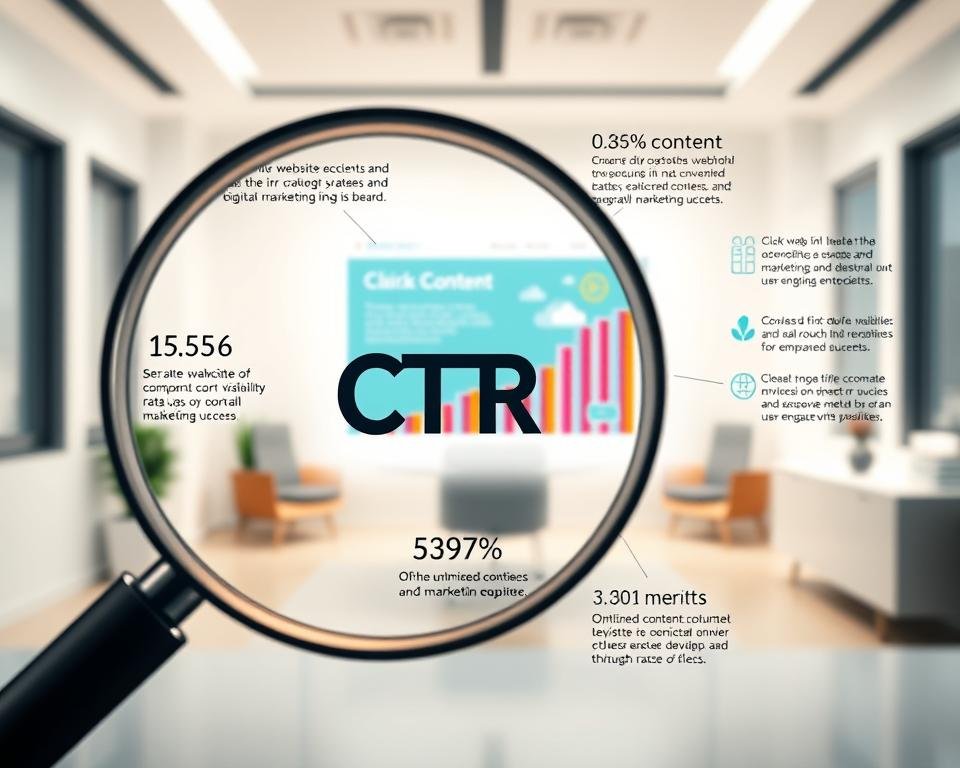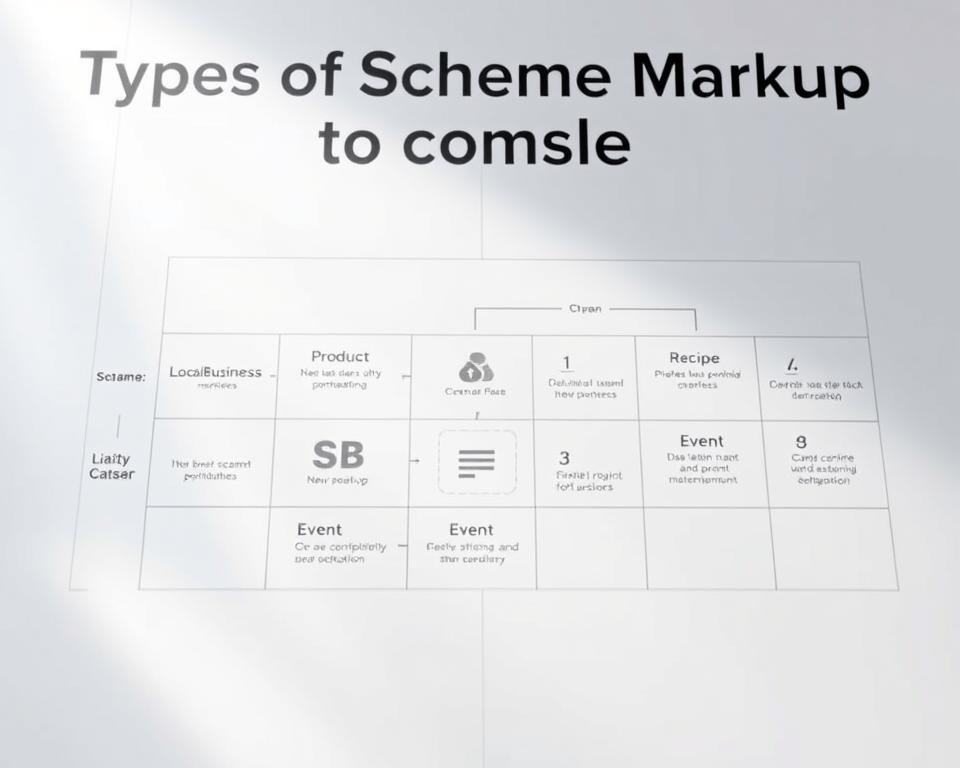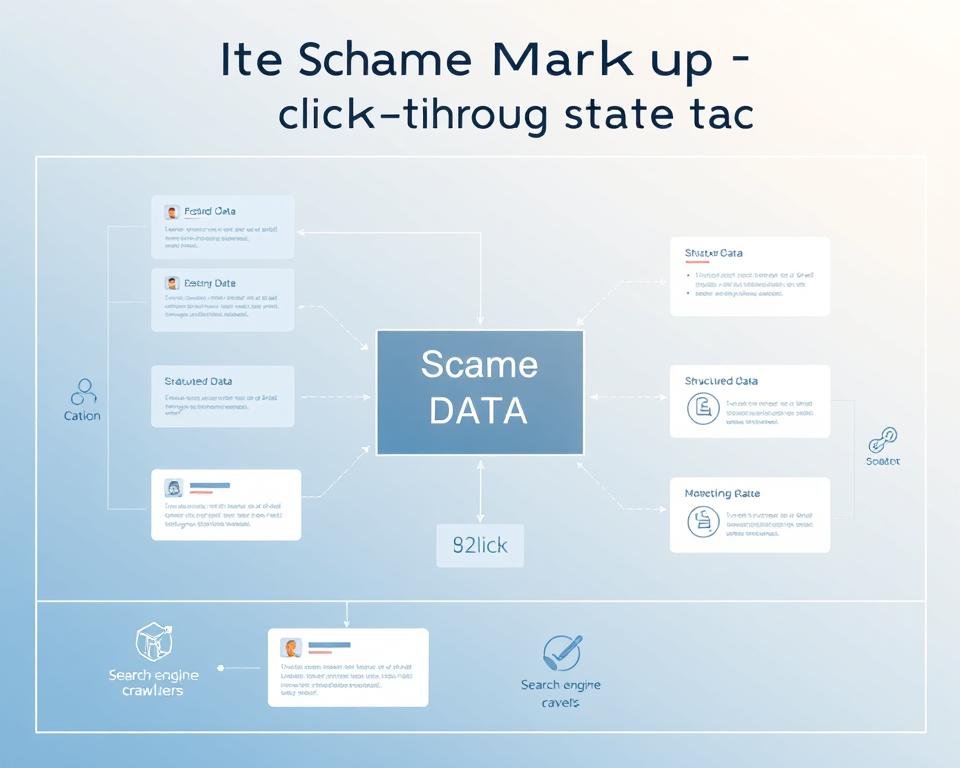I have always been fascinated by the impact of search engine optimization on a website’s online presence. One crucial aspect that has caught my attention is schema markup, a tool that helps search engines understand the content and context of a webpage.
By leveraging schema markup, website owners can significantly improve their website’s visibility, drive more organic traffic, and ultimately boost their click-through rates. In this article, I will delve into the world of schema markup and explore its potential in enhancing CTR.
Key Takeaways
- Understand the basics of schema markup and its role in SEO
- Learn how to implement schema markup on your website
- Discover the types of schema markup that can improve CTR
- Explore the benefits of using schema markup for your online presence
- Find out how schema markup can drive more organic traffic to your site
What is Schema Markup?
Schema markup is a form of structured data that provides search engines with additional context about a webpage’s content. This context helps search engines understand the information on a webpage, making it more likely to be displayed as a rich snippet in search engine results pages (SERPs). By enhancing the visibility of a webpage, schema markup plays a crucial role in improving click-through rates.
Definition and Purpose
The primary purpose of schema markup is to provide search engines with structured data that can be used to enhance the display of a webpage in SERPs. Schema markup achieves this by defining the meaning of the content on a webpage, making it easier for search engines to comprehend. This comprehension is crucial for search engines to accurately index and display webpages in response to user queries.
Schema markup is implemented using a specific vocabulary of microdata tags that are added to a webpage’s HTML. These tags provide search engines with additional information about the content, such as reviews, events, or business hours. By incorporating schema markup, website owners can enhance the visibility of their webpages and improve their chances of being displayed as rich snippets.
How It Works
Schema markup works by providing search engines with a clear understanding of the content on a webpage. When a search engine crawls a webpage, it looks for schema markup to understand the context and meaning of the content. This understanding enables search engines to display the webpage in a more informative and appealing way, such as through rich snippets.
The process involves adding schema markup code to a webpage’s HTML, which is then read by search engines. The schema markup code provides search engines with specific information about the content, such as the type of content, its relevance, and its context. By using schema markup, website owners can influence how their webpages are displayed in SERPs.
Common Schema Types
There are several common types of schema markup that can be used to enhance the visibility of a webpage. Some of the most popular schema types include:
- Local Business Schema: Provides information about a local business, such as its name, address, and business hours.
- Product Schema: Offers details about a product, including its price, availability, and reviews.
- Review and Rating Schema: Displays reviews and ratings for a product, service, or business, helping to build credibility and trust with potential customers.
By using these schema types, website owners can provide search engines with a wealth of information about their content, enhancing its visibility and appeal in SERPs.
Importance of Click-Through Rates (CTR)
As a key performance indicator, click-through rates provide valuable insights into user engagement and website effectiveness. Click-through rates (CTR) are a crucial metric that measures the ratio of users who click on a specific link to the number of total users who view a page, email, or advertisement. A high CTR indicates that a webpage is relevant and appealing to users.
In the context of search engine optimization (SEO), CTR is significant because it reflects how well a webpage is matched to the search query. Search engines like Google use CTR as one of the factors to determine the relevance and ranking of a webpage. Therefore, understanding and improving CTR is essential for enhancing a website’s visibility and search engine ranking.

Role of CTR in SEO
The role of CTR in SEO is multifaceted. Firstly, a high CTR suggests that a webpage is relevant to the search query, which can positively influence its ranking. Secondly, CTR is a reflection of how well the title tags, meta descriptions, and other elements of a webpage are optimized to attract users. By improving these elements, website owners can increase their CTR and, consequently, their search engine rankings.
Moreover, CTR is closely linked to user experience. A webpage with a high CTR is likely to provide users with the information they are looking for, thereby enhancing their overall experience. This, in turn, can lead to increased user engagement, longer session durations, and ultimately, a higher conversion rate.
Impact of High CTR on Website Success
A high CTR can have a significant impact on the overall success of a website. By attracting more users to click on their webpage, website owners can increase their website traffic, which can lead to more conversions, sales, and revenue. Furthermore, a high CTR can also improve a website’s credibility and trustworthiness, as users are more likely to trust a webpage that appears at the top of search engine results.
In addition, a high CTR can provide website owners with valuable insights into user behavior and preferences. By analyzing CTR data, website owners can identify areas for improvement and optimize their webpages to better meet the needs of their target audience.
Implementing Schema Markup: A Step-by-Step Guide
Schema markup implementation can seem daunting, but with a step-by-step guide, you can enhance your website’s visibility in search engine results. To start, it’s essential to understand the process involved in implementing schema markup effectively.
Identifying Relevant Content Types
The first step in implementing schema markup is to identify the types of content on your webpage that can benefit from structured data. This includes articles, events, reviews, and business information. By understanding what content you have, you can determine the most appropriate schema markup to apply.
For instance, if your website features a lot of product reviews, you might want to use schema markup to highlight review ratings and improve your visibility in search results.

Choosing the Right Schema Markup
Once you’ve identified your content types, the next step is to choose the right schema markup. Schema.org offers a wide range of schema types, so it’s crucial to select the ones that best describe your content. For example, if you have a local business website, you might use the LocalBusiness schema to provide search engines with detailed information about your business, such as your address, phone number, and operating hours.
Using Google’s Structured Data Markup Helper
To simplify the process of adding schema markup to your webpage, Google provides a useful tool called the Structured Data Markup Helper. This tool allows you to visually select the elements on your webpage that you want to mark up and then generates the necessary HTML code. By using this tool, you can ensure that your schema markup is correctly implemented and compatible with Google’s requirements for SERP optimization.
After generating the HTML code, you can easily add it to your webpage’s HTML to complete the schema markup implementation.
Types of Schema Markup to Consider
To maximize the effectiveness of schema markup, it’s essential to understand the different types available. Schema markup is not a one-size-fits-all solution; various types cater to different needs and can significantly enhance your website’s visibility in search results.
Local Business Schema
Local Business schema is particularly useful for businesses that serve a specific geographic region. By implementing this type of schema, you can display your business’s name, address, and phone number (NAP) in search results, making it easier for local customers to find you.
Key benefits of Local Business schema include:
- Increased visibility in local search results
- Improved accuracy of business information online
- Enhanced credibility with search engines

Product Schema
Product schema is designed for e-commerce websites, allowing you to display detailed product information such as price, availability, and reviews directly in search results. This can significantly enhance the user experience and drive more qualified traffic to your site.
Advantages of using Product schema include:
- Displaying product prices and availability
- Showcasing product reviews and ratings
- Improving product visibility in search results
Review and Rating Schema
Review and Rating schema enables you to showcase customer reviews and ratings directly in search results, making your webpage more appealing to potential customers. This type of schema can increase trust and credibility, driving higher click-through rates.
Benefits of Review and Rating schema include:
- Increased trust and credibility with potential customers
- Enhanced visibility with review snippets
- Improved click-through rates due to the display of ratings
By understanding and implementing these different types of schema markup, you can significantly enhance your website’s search engine visibility and improve user engagement.
Testing Your Schema Markup
Testing schema markup is a vital step in the SEO process, helping you identify and fix issues before they impact your site’s performance. By validating your schema markup, you can ensure that search engines correctly interpret your webpage’s content, which is crucial for enhancing click-through rates.
Tools for Validation
Several tools are available to help you validate your schema markup. One of the most effective tools is Google’s Rich Results Test. This tool allows you to enter your webpage’s URL or code snippet and check if your schema markup is correct and eligible for rich results.
Other tools include:
- Google’s Structured Data Markup Helper: A tool that helps you create and test schema markup.
- Schema.org’s Validator: Although primarily focused on schema.org vocabulary, it can help identify basic markup issues.
- Third-party SEO tools: Many SEO tools, such as Ahrefs and SEMrush, offer schema markup validation features.
Checking Performance with Google Search Console
After validating your schema markup, the next step is to monitor its performance using Google Search Console. This tool provides insights into how your webpage is performing in search results, including the number of impressions, clicks, and average position.
To check the performance of your schema markup in Google Search Console:
- Navigate to the “Performance” report.
- Filter the data by date, query, or page to analyze specific trends.
- Look for improvements in click-through rates and impressions for pages with schema markup.

By regularly testing and monitoring your schema markup, you can identify areas for improvement and make adjustments to maximize your webpage’s visibility and click-through rates.
Common Mistakes to Avoid
The effectiveness of schema markup depends on avoiding certain critical errors. When implementing schema markup, it’s essential to be aware of the potential pitfalls that can impact your website’s performance.
Overusing Schema Markup
One of the most significant mistakes is overusing schema markup. While it might be tempting to apply schema markup to every piece of content on your website, doing so can lead to penalties from search engines. Search engines like Google have guidelines against excessive use of structured data, and violating these guidelines can result in a decrease in your website’s ranking.
To avoid this, focus on applying schema markup to the most critical and relevant content on your website. This could include product descriptions, reviews, and business information. By doing so, you can enhance your website’s visibility without risking penalties.

Neglecting Mobile Optimization
Another crucial mistake is neglecting mobile optimization. With the majority of web traffic coming from mobile devices, ensuring that your schema markup is optimized for mobile is vital. Mobile-friendliness is a key ranking factor, and schema markup that doesn’t work well on mobile devices can hinder your website’s performance.
| Optimization Aspect | Desktop | Mobile |
|---|---|---|
| Schema Markup | Essential for search engines | Critical for user experience |
| Page Loading Speed | Important for user engagement | Crucial for reducing bounce rates |
| Responsive Design | Enhances user experience | Essential for accessibility |
By avoiding these common mistakes, you can ensure that your schema markup is effective in enhancing your website’s click-through rates and improving your webpage’s ranking. Regularly auditing your schema markup and staying updated with the latest best practices can help you maximize the benefits of structured data.
Enhancing User Experience with Rich Snippets
I have found that rich snippets are an effective way to make a webpage stand out in search engine results pages (SERPs). By providing users with additional information about the content on a webpage, rich snippets can significantly enhance user experience and improve click-through rates (CTR).
Rich snippets are essentially enhanced search results that display extra details about a webpage, such as reviews, ratings, prices, or event dates. These snippets are generated using schema markup, which helps search engines understand the content and context of a webpage.
What Are Rich Snippets?
Rich snippets are the enhanced search results that appear in SERPs due to the implementation of schema markup. They provide users with a preview of the content on a webpage, making it easier for them to determine whether the page is relevant to their search query.
The use of rich snippets can be particularly beneficial for certain types of content, such as:
- Reviews and ratings
- Events and calendars
- Products and prices
- Recipes and cooking instructions
Benefits of Rich Snippets for CTR
Rich snippets offer several benefits that can improve CTR, including:
- Increased visibility: Rich snippets make a webpage stand out in SERPs, drawing more attention from users.
- Improved relevance: By providing additional context, rich snippets help users determine whether a webpage is relevant to their search query.
- Enhanced credibility: Rich snippets can include reviews, ratings, and other trust indicators that enhance a webpage’s credibility.
By leveraging rich snippets, website owners can create a more engaging and informative search result that attracts more clicks and drives traffic to their site.
Case Studies: Schema Markup Success Stories
The strategic use of schema markup has led to remarkable improvements in click-through rates across various industries. By examining real-world examples, we can gain valuable insights into how schema markup can be effectively utilized to enhance CTR.
Examples Across Different Industries
Several businesses have successfully implemented schema markup to improve their online presence. For instance, a local business in the United States saw a significant increase in CTR after implementing Local Business Schema, which provided users with essential information such as business hours and address.
A product-based company utilized Product Schema to showcase detailed product information, including price and availability, resulting in a notable boost in sales.

Another example is a review website that implemented Review and Rating Schema, allowing users to quickly identify top-rated products and services. This not only improved CTR but also enhanced user experience by providing valuable information at a glance.
Lessons Learned from Successful Implementations
Analyzing these case studies reveals several key takeaways:
- Identifying the right schema type for your content is crucial.
- Proper implementation is key to reaping the benefits of schema markup.
- Regularly updating and refining schema markup is necessary to maintain its effectiveness.
The following table summarizes the outcomes of these case studies:
| Industry | Schema Type | CTR Improvement |
|---|---|---|
| Local Business | Local Business Schema | 25% |
| E-commerce | Product Schema | 30% |
| Review Website | Review and Rating Schema | 40% |
By understanding and applying these lessons, businesses can harness the power of schema markup to improve their CTR and overall online success.
Keeping Up with Schema Markup Best Practices
To maximize the benefits of schema markup, it’s crucial to stay current with the latest best practices. Schema markup is a vital component of search engine optimization (SEO), and its effectiveness depends on how well it is implemented and maintained.
As search engines continue to evolve, the guidelines and recommendations for schema markup also change. Therefore, staying informed about the latest developments is essential to ensure that your website remains optimized for search engines.
Staying Updated with Schema.org
Schema.org is the official repository of schema markup documentation, and it is the go-to resource for understanding the different types of schema markup and their applications. To stay updated with the latest schema markup best practices, it’s essential to regularly visit Schema.org and review the latest documentation.
Some of the key updates to look out for on Schema.org include new schema types, changes to existing schema types, and updates to the guidelines for implementing schema markup. By staying informed about these updates, you can ensure that your website’s schema markup remains effective and compliant with the latest standards.
Regularly Auditing Your Markup
Regularly auditing your schema markup is crucial to ensure that it remains effective and continues to drive organic traffic to your website. This involves reviewing your website’s schema markup to identify any errors, inconsistencies, or areas for improvement.
A thorough audit should include checking for:
- Correct implementation of schema markup
- Consistency in schema markup across the website
- Relevance of schema markup to the content
- Compliance with the latest schema markup guidelines
By regularly auditing your schema markup, you can identify and address any issues that may be impacting its effectiveness, ensuring that your website continues to benefit from improved click-through rates and increased organic traffic.

The following table highlights the key benefits of staying updated with schema markup best practices and regularly auditing your markup:
| Best Practice | Benefits | Impact on Organic Traffic |
|---|---|---|
| Staying updated with Schema.org | Ensures compliance with the latest schema markup guidelines | Increased organic traffic through improved search engine rankings |
| Regularly auditing schema markup | Identifies and addresses errors and inconsistencies | Improved click-through rates and increased organic traffic |
| Correct implementation of schema markup | Enhances search engine understanding of website content | Increased organic traffic through improved search engine rankings |
By following these best practices and staying informed about the latest developments in schema markup, you can maximize the benefits of schema markup and drive more organic traffic to your website.
Conclusion: The Future of Schema Markup and CTR
As we continue to navigate the evolving landscape of search engine optimization, it’s clear that schema markup plays a crucial role in boosting click-through rates. By understanding how to effectively use schema markup, website owners can significantly enhance their online visibility and drive more traffic to their sites.
Emerging Trends in Schema Markup
The future of schema markup is likely to be shaped by advancements in artificial intelligence and voice search. As these technologies continue to develop, we can expect to see new schema types and more sophisticated ways of implementing schema markup to improve CTR. Staying ahead of these trends will be essential for maintaining a competitive edge in search engine rankings.
Practical Advice for Ongoing Improvement
To maximize the benefits of schema markup, I recommend regularly auditing your website’s markup to ensure it remains up-to-date and aligned with the latest best practices in search engine optimization. By doing so, you can continue to improve your website’s CTR and overall online performance.
